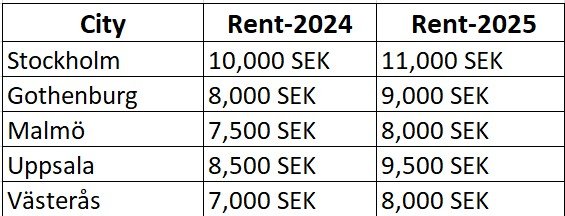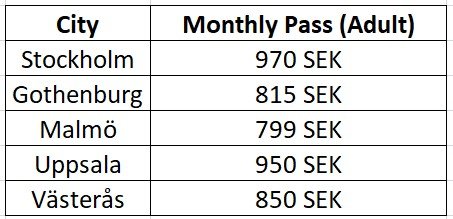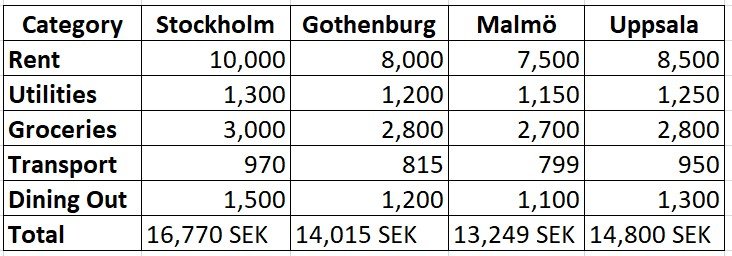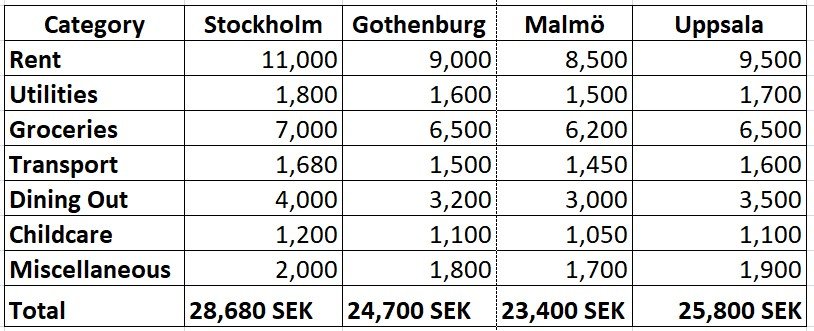“Stockholm is undoubtedly the economic and administrative heart of Sweden, which drives up its cost of living, particularly in housing, but regional cities like Gothenburg, Malmö, and Uppsala offer comparable public services and quality of life at significantly lower living expenses.” — Dr. Lars Pettersson, Professor of Urban Economics, Uppsala University.
When I moved to Sweden, I started out in Stockholm—but over time, I got curious about how life (and expenses) stack up in other cities. If you’re wondering whether Stockholm is really that expensive, or if you’d save money in cities like Malmö or Gothenburg, this guide is for you.
I started asking friends who live in other places like Gothenburg, Malmö, and Uppsala. They pay less for rent and even for daily things like eating out or using public transport.
I’ve put together a personal comparison based on what I’ve seen, paid, and experienced across different Swedish cities. The tables below will help you decide which city fits your lifestyle—and your wallet.
1. Rent Prices – Stockholm vs Other Cities
Renting a home in Stockholm can be expensive. A small studio in the city centre costs around 10,000 SEK per month. Outside the centre, it’s cheaper—about 7,000 SEK. A 2-bedroom apartment in the city centre costs around 19,000 SEK, while outside the centre it’s about 11,000 SEK.
Rent is one of the biggest living expenses in Sweden. Stockholm is definitely on the higher end, but the difference surprised me in some places.

In my case, moving just 40 minutes outside Stockholm dropped my rent by about 3,000 SEK.
2. Utilities and Internet – Not a Huge Difference
In Stockholm, utility costs are usually easy to manage. Electricity and water cost about 1,000 SEK per month, but may be a bit higher in winter. Internet is around 350 SEK. A TV package costs about 150 SEK, and a basic mobile plan is around 200 SEK. These costs are steady, so it’s easy to plan your budget.
Utility prices don’t vary that much between cities—but housing type and insulation matter.

3. Grocery Costs – Almost the Same Everywhere
Groceries in Stockholm are fairly priced. Milk costs about 15 SEK per litre. Chicken is around 110 SEK per kilo, and eggs are 40 SEK for a dozen. Bread is 25 SEK, and a bottle of beer is about 20 SEK. Fruits like apples and bananas cost around 30 SEK per kilo. A chocolate bar or a bottle of wine is around 20 and 100 SEK, respectively.
A single person spends about 3,000 SEK per month on groceries. For a family of three, it’s around 7,000 SEK.
Supermarkets like ICA, Coop, and Lidl are found in most cities, so food prices are quite consistent. But local deals can help cut costs.


4. Eating Out – Stockholm Is the Priciest
Eating out in Stockholm is common. A coffee costs about 35 SEK, and a croissant is 25 SEK. A hamburger is around 100 SEK, and a kebab is about 90 SEK. Pizza usually costs 130 SEK. Dinner at a restaurant is about 300 SEK per person, not including drinks. A glass of wine costs around 100 SEK, and beer is about 70 SEK.
If you eat out a few times a month, expect to spend about 1,500 SEK as a single person, or around 4,000 SEK for a family.
I love grabbing a coffee or burger when I’m out. In smaller cities, it’s easier to enjoy eating out more often.

5. Public Transport – Stockholm Has the Most Expensive Pass
Public transport in Stockholm is easy to use and affordable. A monthly pass costs around 840 SEK, giving you unlimited travel on buses, trains, and the metro.
If you own a car, it’s more expensive. Car insurance is about 500 SEK per month, and road taxes are around 200 SEK. Tolls can add another 500 SEK, and gasoline costs 20–25 SEK per litre. Driving regularly can bring your car expenses up to 2,000 SEK or more per month.
While owning a car offers flexibility, it’s much more expensive than using public transport.
I mostly use public transport, so this is something I notice month to month. Stockholm has the most extensive system—but it also costs more.

If you live in a smaller city and don’t commute far, you can often walk or bike more—cutting this cost entirely.
6. Healthcare – Uniform Nationwide
Healthcare in Sweden is affordable due to government subsidies. A visit to the doctor typically costs around 200 SEK, and specialist visits are about 400 SEK. Sweden has an annual cap on healthcare fees, so once you spend between 1,400 and 2,800 SEK, any further visits are free for the rest of the year.
Prescriptions are also subsidized, reducing costs. Dental care is free for children and young people until they turn 23. This applies to both private and public dental care.
Sweden’s public healthcare system is consistent. What you pay in Stockholm is about the same everywhere.

7. Education & Childcare – Nationally Regulated
In Sweden, public schools are free and offer high-quality education for all children. This helps families save on education costs.
Day-care is also available for young children, with fees based on family income. Most families pay between 1,000 and 1,500 SEK per month for day-care, making it affordable.
Sweden’s system ensures all children have access to early education and care, no matter the family’s income.
Schools and daycare follow national guidelines. Fees vary slightly based on city income brackets, but not by much.

8. Entertainment & Lifestyle
Living in Stockholm offers plenty of leisure options for all interests. A standard haircut costs around 400 SEK. A cinema ticket is about 160 SEK, and a monthly gym membership is around 400 SEK.
For children, music classes or swimming lessons typically cost 1,200 SEK per month. If you’re looking for family fun, a ticket to Gröna Lund amusement park costs about 500 SEK per person.
Here’s where lifestyle costs can vary—gyms, movie tickets, and fun are slightly cheaper outside the capital.

Summary: Monthly Living Cost Comparison
Single Person
For a single person living in Stockholm, monthly expenses can be broken down as follows: Rent for a studio apartment outside the city centre costs around 7000 kronor. Utilities, including electricity and water, add approximately 1300 to the monthly budget. Groceries come to about 3000 per month, and dining out occasionally costs around 1500. Public transport is a convenient option, with a monthly pass costing about 840 kronor. For those interested in fitness, a gym membership averages 400 SEK per month.

Altogether, the total monthly expenses for a single person living in Stockholm are approximately 14000-15000 kronor.
Family of 3 Members
Now for a family of three living in Stockholm, monthly expenses are generally as follows: Rent for a 2-bedroom apartment outside the city centre is around 11000 kronor. Utilities, including electricity and water, typically cost about 1800 kronor per month. Grocery expenses for the family come to approximately 7000 each month, while dining out occasionally adds up another 4000 kronor to the budget. Public transport for two adults is 1680 kronor monthly, and for fitness, gym memberships for two adults you will pay 800 kronor.

Altogether, the total monthly expenses for a family of three in Stockholm come to approximately 26280 Swedish kronor.
Is Stockholm the most expensive city in Sweden to live in?
Yes, Stockholm usually has higher rent and eating out costs compared to other cities.
Are groceries cheaper in smaller Swedish towns?
Not really. Grocery prices are quite similar across the country thanks to big supermarket chains.
Can I save money by living outside Stockholm?
Absolutely! Living 30–40 minutes outside the city can cut rent and some daily expenses.
How does public transport cost in Stockholm compare to other cities?
Stockholm’s transport is more expensive, but also the most complete. Smaller cities often don’t need passes at all.
How does the cost of living in Stockholm compare to other Swedish cities for families?
Families often spend more in Stockholm, especially on rent and eating out. But daycare and school costs stay the same everywhere.
Conclusion
If you want to live in Sweden without spending too much, cities like Malmö or Västerås are great alternatives. Stockholm is vibrant and exciting—but with a higher price tag. Personally, I found balance by living just outside the capital and commuting in.
No matter which city you choose, Sweden offers a high standard of living, excellent public services, and beautiful surroundings. Just plan your budget wisely—and enjoy the fika!






